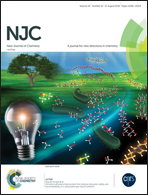A naphthalimide-based fluorescence ‘‘turn-on’’ chemosensor for highly selective detection of carbon monoxide: imaging applications in living cells†
Abstract
A naphthalimide-based fluorescence chemosensor, COFP, was designed and synthesized for the detection of carbon monoxide (CO) in HEPES buffer (pH 7.4, 37 °C). The detection process is highly selective towards CO, over a variety of relevant reactive oxygen, nitrogen, and sulfur species. Also, the fluorescence response is not hampered in the presence of biologically relevant metal ions and/or species. The detection method was achieved through the transformation of the nitro group of COFP to an amino functionalized derivative in the presence of CO without using any heavy metals e.g. Pd, Rh, Ru etc. The chemosensor prompted a ‘turn-on’ fluorescence response to CO with a simultaneous increase of the fluorescence intensity by more than 33 times. The LOD (limit of detection) was calculated to be as low as 123 nM using the 3σ method. Moreover, the chemosensor is capable of monitoring the changes in intracellular CO in the C6 glioma cell line.



 Please wait while we load your content...
Please wait while we load your content...